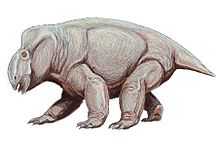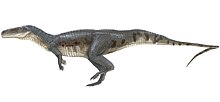Chinle formation
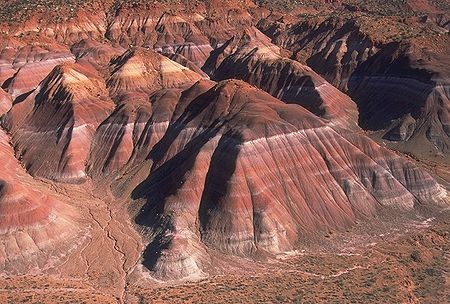
The Chinle Formation is a lithostratigraphic rock unit of sedimentary origin, during the Upper Triassic before around 228 to 200 million years ago in the American US states Arizona (North), Colorado (west), Nevada , New Mexico (west) and Utah for deposition came. Geologically, it belongs to the Colorado Plateau , the Basin and Range and the southern section of the Interior Plains .
stratigraphy

history
The Chinle formation has no type locality . It was named in 1917 by Gregory after the Chinle Valley in Apache County , Arizona (although he had used the same name two years earlier, he had not expressed any interest in scientific recognition at the time). Members were separated from Robeck for the first time in 1956 and from Stewart in 1957. Poole and Stewart made an overview in 1964. Sikich carried out a revision of the formation in 1965 and left other members at the same time. The geographic extent was mapped out in 1967 by Wilson and Stewart. Stewart et al. Made changes to the geographic extent in 1972 and published a revision that same year. Kelley introduced additional shift members in 1972 and revised the formation. This was repeated by Lucas and Hayden in 1989. Dubiel introduced the Rock Point Member in 1989 .
In 1993 Lucas raised the formation to a group and thus the members of the layer became formations. He also integrated the Dockum group of eastern New Mexico and western Texas into the newly created Chinle group . His approach is controversial, and many geologists, including the USGS, still stick to the concept of formation and continue to distinguish the Dockum group. The Dockum group was first described in 1890, long before the Chinle formation. According to the current stratigraphic custom, the Chinle group should therefore actually be incorporated into the Dockum group and not the other way around.
General overviews were written by Dubiel et al. In 1992 and by Hintze and Ax in 1995.
General overview
After the Sonoma mountain formation subsided , the Sonoma Mountains on the border with California had lifted out and sealed off a shallow sea basin from the west. The then west coast ran in a north-south direction through central Nevada. The Chinle Formation deposited in the flat hinterland to the east is of purely continental origin ( red sediments ), it consists mainly of sandstones , slate and occasional freshwater limestone. The sediments were either deposited in rivers with the associated floodplain landscapes and alluvial plains or in lakes, marshes and deltas. The lowest member of the layer, the Shinarump member , filled huge paleo river valleys with gravel and coarse sandstones, which had cut deep into the underlying Moenkopi formation . A river system that drains to the northwest, the so-called Chinle River, formed . It probably had its origin in the Amarillo Wichita Uplift in northwest Texas. In northern New Mexico it flowed through a barrier from the Pedernal Uplift in the south and the Uncompahgre Uplift in the north, before finally flowing into the sea basin in northern Nevada. This huge river system is believed to have existed almost to the end of the Chinle Formation.
Incorporated in the largely fluvial sediments, there are also volcanic deposits, mostly ashes but also boulders. The area of origin of the volcanic component was probably the southward Mogollon Rim and the igneous island arc on the southwestern edge of the American continent. Silicon that was easily extracted from these volcanic rocks was responsible, for example, for the silicification of tree trunks in the Petrified Forest Member and thus their unique preservation.
The climatic conditions are considered to be tropical-humid due to the location of North America near the equator. Towards the end of the Chinle period, the climate became drier and there were pronounced dry seasons, which can be seen in the occasional dry marshland of the Petrified Forest Member. At the same time there was a gradual retreat of the Absaroka Sea to the west.
structure
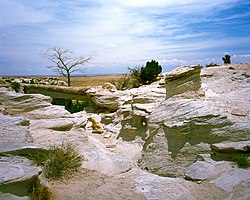
The Chinle Formation normally overlays the uppermost strata of the Moenkopi Formation in a discordant manner , only in the southwest of Colorado does it even reach down to the Cutler Formation . The layer gap formed represents a period of approximately 20 to 25 million years (minimum value). The Chinle Formation is in turn covered discordantly by the Moenave Formation or the Wingate Sandstone from the Glen Canyon Group .
The Temple Mountain member is listed as the stratigraphically lowest unit , although in most areas it is still subordinate to the Shinarump member . The Shinarump member consists of river sediments from a pigtail facies. For its part, it is mostly overlaid by the Monitor-Butte-Member , a distal floodplain facies with activated lacustric sediments. The fluvial Moss-Back-Member follows in the west of the deposit area . Usually, however, the Monitor Butte member gradually changes into the Petrified Forest member . The Petrified Forest Member consists predominantly of overflow sediments in which thin lenses from river bed and lake sediments appear. In Arizona and New Mexico it is divided by the Sonsela Sandstone Member into a Lower Petrified Forest Member and an Upper Petrified Forest Member . The Sonsela Sandstone Member also consists of plait stream deposits. The Petrified Forest Member shows a gradual transition to the Owl Rock Member - marginal lacustrian to fully lacustrian sediments of a possibly very large inland lake. The Owl-Rock-Member is followed by either the Rock-Point-Member or the Church-Rock-Member . The suspicion is expressed that the two members of the layer are synonymous. Both are complex, plurifacial sediment bodies (pigtail, lake and overflow sediments).
In terms of sequence stratigraphy , the Chinle formation can be divided into three sequences, which can be separated from one another by means of discordances. At the bottom lie conglomerates and sandstones from eroding rivers. Above this, clayey sediments follow an alluvial plain with the formation of paleo soils. The third sequence consists of alternating siltstones and fine-grain sandstones; it shows a trend towards increasingly Aeolian conditions.
Age
On the basis of fossil finds, the Chinle Formation can be assigned to the period Lower Carnian to Rhaetian , i. H. an absolute age of around 228 to 200 million years BP.
So far, absolute age information is relatively rare. The top member has a U / Pb age of 207 ± 2 MA BP from reconditioned tuffs. The Black Forest Bed , a sandstone layer containing tuff in the Upper Petrified Forest Member, resulted in U / Pb dating of 213 ± 1.7 MA BP.
Here are biostratigraphic age correlations in established by Lucas Country vertebrate biozones ( Engl. Country vertebrate faunachron - LVF ) are based. These biozones are based on the first or last appearance of phytosaurs . The somewhat simplified stratigraphy is based on Litwin.
| Age | Biozone | Layer member |
|---|---|---|
| Rhaetium | Apacheum | Rock Point Member / Church Rock Member |
| Norium | Revueltium | Owl Rock Member Upper Petrified Forest Member |
| Upper lower carnium and upper carnium | Adamanium | Sonsela-Sandstone-Member Lower-Petrified-Forest-Member Moss-Back-Member Monitor-Butte-Member |
| Lower lower carnium | Otischalkium | Shinarump member Temple Mountain member |
The Newark Supergroup with a very similar fauna in the eastern United States, the Santa Maria Formation and the Caturrita Formation in Brazil and the Middle Keuper in Germany should be mentioned at roughly the same time .
Mightiness
The Chinle Formation reaches its maximum thickness of around 520 meters in the southern part of its sedimentation area. The individual strata of the Chinle Formation are subject to strong fluctuations in thickness.
Shift members
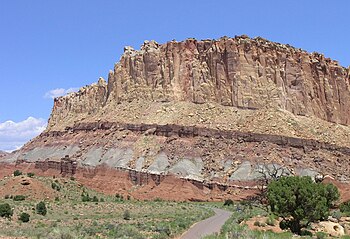
With group status (in alphabetical order - but not recognized by the USGS)
- Petrified Forest Formation (AZ, UT, NM)
- San Pedro Arroyo Formation (NM)
- Santa Rosa Formation (NM)
- Shinarump Formation (NM).
- Many more
With formation status (in alphabetical order - members without an asterisk (*) are not recognized by the USGS)
- Agua Zarca Sandstone Member (NM)
- Bluewater Creek Member (AZ, CO, NM)
- Church-Rock-Member (AZ *, CO *, UT *)
- Correo Sandstone Member (NM)
- Cuervo Sandstone Member (NM)
- Duffin Sandstone Member (UT)
- Gartra member (CO *, UT *)
- Mesa Redondo Member (AZ *, NM *)
- Monitor-Butte-Member (AZ *, CO *, UT *)
- Moss-Back-Member (AZ *, CO *, UT *)
- Newspaper-Rock-Sandstone-Bed (AZ)
- Owl-Rock-Member (AZ *, NM *, UT *)
- Petrified Forest Member (AZ *, CO *, NV *, NM *, UT *)
- Poleo Sandstone Lentil (NM)
- Redonda Member (NM)
- Rock Point Member (AZ *, NM *)
- Salitral Shale Tongue (NM *),
- Shinarump member (AZ *, NV *, NM *, UT *)
- Silver Reef Sandstone Member (UT)
- Stanaker member (UT)
- Temple Mountain Member (UT *)
- Trail Hill Sandstone Member (UT)
Occurrence
The Chinle Formation occurs in the following geological sedimentation areas:
- Black Mesa Basin
- Great Basin
- Geen River Basin
- Las Vegas Basin / Raton Basin
- Orogrande basin
- Palo Duro cymbals
- Paradox Basin
- Permian Basin
- Piceance Basin
- San Juan Basin
- Sierra Grande uplift
- Uinta basin
- Uinta Uplift
- Wasatch uplift
Also in the following national parks and parks (incomplete list):
- Canyonlands National Park - see Canyonlands Geology
- Capitol Reef National Park - see Geology of Capitol Reef
- Glen Canyon National Recreation Area - see Glen Canyon Geology
- Petrified Forest National Park - see Geology of Petrified Forest National Park
- Zion National Park - see Geology of Zion National Park
The equivalence of the Chinle Formation to the Dockum Group in eastern Colorado, eastern New Mexico, southwest Kansas , western Texas, and the Oklahoma Panhandle remains controversial. In New Mexico and sometimes in Texas, the Chinle formation is somewhat liberal as a formation within the Dockum group.
In northwestern Colorado and northeastern Utah, the Chinle Formation occupies a separate, separate sedimentation basin.
Paleo floors
The most varied stages of development and types of paleo soils can be observed in the Chinle Formation . To form came Calcisole , Gleye , loamy tropical soils , calcareous desert soils and Parabraunerden .
- Calcareous desert soils: Church Rock Members
- Calcisole: Owl Rock and Church Rock members
- Clayey tropical soils: Monitor Butte and Petrified Forest members
- Parabraunerden: Monitor Butte and Petrified Forest members
- Gleye: Shinarump member
The soil types found clearly reflect the increasing aridity in the upper strata.
Fossil content
The Chinle Formation has a very rich vertebrate fauna . It is the oldest formation in North America that leads real dinosaurs (for example Coelophysis ). In addition to numerous theropods , it also contains sauropods and ornithischia ( Krzyzanowskisaurus ). There are also aetosaurs , amphibians , archisauriformes , archosaurs , dicynodonts , primitive crocodiles and numerous phytosauria . Remains of real bony fish , lung fish ( Arganodus ) and freshwater sharks ( Lissodus and Xenacanthus ) can also be found.
Vertebrates
Noteworthy is the Petrified Forest Member with its huge silicified coniferous tree trunks ( Araucarioxylon arizonicum ), which reach up to 60 meters, as well as the Ghost Ranch site in northern New Mexico, where thousands of Coelophysis were washed up.
There are also a lot of trace fossils in the Chinle Formation . Among them are the tracks of large amphibians, of various archosaurs such as Anchisauripus sillimani and Rhynchosauroides , of small primeval dinosaurs (caused e.g. by Coelophysis), of prosauropods and of mammal-like reptiles. The grailator tracks (small dinosaurs) are becoming more and more common in the upper layers of the Chinle formation. Also coprolites occur.
The invertebrates include gastropods , mussels and ostracods .
The Chinle Formation also contains numerous traces and structures of invertebrates such as annelids , crayfish , insects ( hymenoptera ), beetles , millipedes and even termites (first appearance in the fossil record).
Examples of buildings are:
- Archeoentomoichnos - termites
- Camborygma - crayfish
- Cylindricum
- Scoyenia - insect larvae
The plant remains are extremely diverse, so the Chinle formation can show over 70 different plant taxa. Available include lycopodiopsida such as Chinlea and Seleginella anasazia , tree ferns as Itopsidema , Bennettiteen as powellii Zamites , ferns as Cladophlebis , Cynepteris lasiophora and Phlebopteris smithii , Ginkgos as Baiera arizonica and Ginkgoites , conifers as Araucariaxylon arizonicum , Arboramosa semicircumtrachea , Brachyphyllum , Dechellyia gormanii , Dinophyton , Masculostrobus clathratus , Pagiophyllum , Schilderia adam anica and Woodworthia arizonica , cycads as Charmorgia , Eoginkgoites davidsonii and Zamites powellii and horsetails as Neocalamites .
Pollen and spores impress with an enormous biodiversity.
Also worth mentioning is the occurrence of amber (oldest amber find in North America), unfortunately without fossil content so far.
Sauropods
| Sauropodomorpha of the Chinle Formation | ||||
|---|---|---|---|---|
| Taxa | Occurrence | Remarks | Illustrations | |
|
Subordination:
|
|

An anchisaurid .
|
||
Theropods
| Theropods of the Chinle Formation | ||||
|---|---|---|---|---|
| Taxa | Occurrence | Remarks | Illustrations | |
|
Genus:
|
|
|
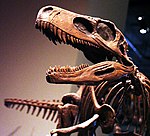
A Herrerasauride .

A Herrerasauride .
|
|
|
Subordination:
|
|
|
||
|
Genus:
|
|
|
||
|
Genus:
|
|
|||
|
Genus:
|
|
|||
|
Family:
|
|
|||
|
Genus:
|
||||
|
Subordination:
|
|
|||
Natural resources
The basal Shinarump-Member and also the Moss-Back-Member show accumulations of copper , uranium (minerals carnotite and uraninite ) and vanadium .
See also
Individual evidence
- ↑ a b c d GEOLEX database entry for Chinle , USGS (viewed 19 March 2006)
- ^ A b R. F. Dubiel: Depositional and climatic setting of the Upper Triassic Chinle Formation, Colorado Plateau. In: SG Lucas, AP Hunt (ed.): Dawn of the Age of Dinosaurs: New Mexico Museum of Natural History. 1989, pp. 171-187.
- ^ SG Lucas: The Chinle Group: revised stratigraphy and biochronology of Upper Triassic Nonmarine strata in the western United States. In: Museum of Northern Arizona Bulletin. v. 59, 1993, pp. 27-50.
- ↑ GEOLEX database bibliographic references for Chinle (viewed 19 March 2006)
- ^ NR Riggs, TM Lehman, GE Gehrels, WR Dickinson: Detrital Zircon Link Between Headwaters and Terminus of the Upper Triassic Chinle-Dockum Paleoriver System. In: Science. Vol. 273, 1996. (PDF file; 1.33 MB)
- ^ NR Riggs, TM Lehmann, GE Gehrels, WR Dickinson: Detrital zircon link between headwaters and terminus of the Upper Triassic Chinle-Dockum paleoriver system. In: Science ,. 273, 1996, pp. 97-100.
- ^ RC Blakey, LT Middleton: Triassic-Jurassic continental systems, northern Arizona. Geological Society of America, Rocky Mountain Section Guidebook, Flagstaff, AZ, 1986, pp. 93-110.
- ^ NR Riggs, SR Ash, JM Mattinson: Isotopic dating of a non-volcanic continental sequence, Chinle Formation, Arizona. In: Geological Society of America Abstracts with Programs. 26 (6), 1994, p. 61.
- ^ NR Riggs, SR Ash, AP Barth, GE Gehrels, JL Wooden: Isotopic age of the Black Forest Bed, Petrified Forest Member, Chinle Formation, Arizona: An example of dating a continental sandstone. In: Geological Society of America Bulletin. 115, 2003, pp. 1315-1323. (PDF; 228 kB)
- ^ RJ Litwin, A. Traverse, SR Ash: Preliminary palynological zonation of the Chinle Formation, southwestern USA, and its correlation to the Newark Supergroup (eastern USA). In: Review of Paleobotany and Palynology. v. 77, 1991, pp. 269-287.
- ↑ Hasiotis et al: A Holistic Approach to Reconstructing Triassic Paleoecosystems: Using Ichnofossils and Paleosols as a Basic Framework. National Park Service Technical Report NPS / NRGRD / GRDTR-98/01, 1998.
- ↑ Hasiotis include: Continental Trace Fossils, Petrified Forest National Park: Tools for Paleohydrologic and Paleoecosystem Reconstructions. Technical Report NPS / NRPO / NRTR-93/11, 1993.
- ^ KB Pig, WC Davis: Anatomically Preserved Plant Reproductive Structures from the Upper Triassic Chinle Formation in Petrified Forest National Park, Arizona. In: NPS Paleontological Research. Vol. 2, p. 177.
- ↑ a b c d e f g h i j k l m n o p q r s t u v w x y z aa ab ac ad David B Weishampel et al .: Dinosaur distribution (Late Triassic, North America). In: David B. Weishampel, Peter Dodson, Halszka Osmólska (eds.): The Dinosauria . 2nd Edition. University of California Press, Berkeley 2004, ISBN 0-520-24209-2 , pp. 518-521.
swell
- WS Baldridge: Geology of the American Southwest. Cambridge University Press 2004, ISBN 0-521-01666-5 .
- TM Lehman: The saga of the Dockum Group and the case of the Texas / New Mexico boundary fault. In: New Mexico Bureau of Mines & Mineral Resources Bulletin. v. 150 1994, pp. 37-51.
- SG Lucas: Global Triassic tetrapod biostratigraphy and biochronology. In: Palaeogeography, Palaeoclimatology, and Palaeoecology. v. 143, 1998, pp. 347-384.


